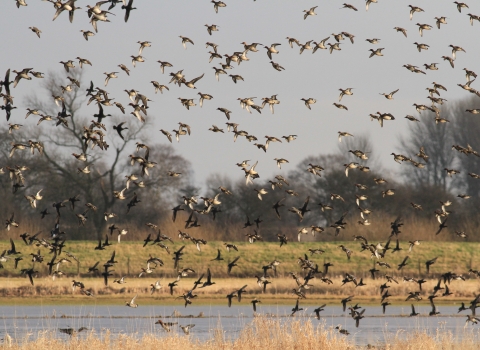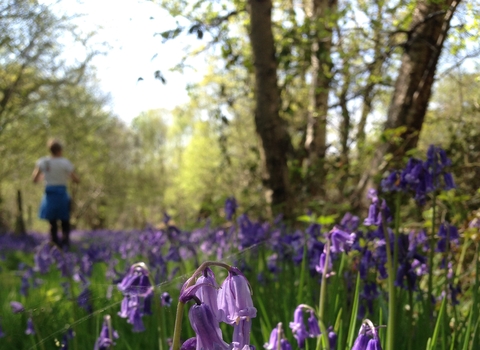Allerthorpe Common - Kirsty Brown
Allerthorpe Common Nature Reserve
Location
Know before you go
Dogs
Not allowed on the reserve, but welcome on leads in Allerthorpe Wood, managed by the Forestry Commission
When to visit
Opening times
Open at all times.We recommend a half day visit – explore Allerthorpe Wood for a longer walk, or head down into the Lower Derwent Valley.
Best time to visit
March to SeptemberAbout the reserve
1086 and all that
Allerthorpe Common’s history can be traced back to AD 1086, when it was recorded in the Domesday Book. Back then it was known as Aluuarstorp, meaning a village belonging to a man called Alfard. We hope Alfard would like what we’ve done with the place since we began managing it in 1966. Some of it would be familiar, and some not – the common itself is a smaller patch of land, now surrounded by pine forest managed by the Forestry Commission, rather than the agricultural land that had come to surround it. The common still has the same kind of mix of habitats, though: wet and dry heath, acid grassland, woodland, scrub and open water.
It's full of wildlife all year round. Ling heather, tormentil, sheep's fescue and wavy hair-grass grow in the drier areas, with cross-leaved heath and purple moor grass grow in damper areas, along with the nationally rare May lily. Patches of gorse provide shelter for birds, and their network of roots supports a healthy population of adders.
Maintaining a healthy heath
The reserve is visited by badgers, foxes and roe deer, and its mature birch and willow trees attract birds including green and great spotted woodpeckers, and flocks of lesser redpolls in winter. Listen out for crossbills calling as they fly around the surrounding forest. Broad-bodied chasers and blue-tailed damselflies are among the many insects you can find around the pools.
We keep the heath healthy with grazing by rare breeds to reduce tree saplings and some coarse grasses, and volunteers regularly control bramble and bracken and remove any birch saplings that the livestock have missed.
Contact us
Environmental designation
About
Allerthorpe Common is alive with wildlife throughout the year and supports a surprising range of habitats for such a small pocket of lowland heath - wet heath, dry heath, acid grassland, woodland, scrub and open water are all waiting to be discovered.
Ling heather, tormentil, sheep's fescue and wavy hair-grass grow on the drier areas of the site. Cross-leaved heath and purple moor grass grow in the damper areas as well as nationally rare May lily. Patches of gorse scrub provide shelter for birds and their network of roots support a healthy population of adders.
Areas of mature birch and willow woodland add another dimension to the site - great spotted woodpecker may sometimes be seen.
One large pool and several smaller ponds support numerous damselfly and dragonfly species including broad-bodied chaser and blue-tailed damselfly.
On-site grazing using rare breed cattle helps keep tree saplings and some of the coarse competitive grasses that can take over the heath in check. Volunteers also work regularly to control bramble and bracken that can become a problem and remove any birch saplings that the cattle have missed.
Read more about the origins of Allerthorpe Common below under 'history'.
Seasonal highlights
- Spring: Plants - May lily; Reptiles - Adder; Birds - Green woodpecker; Woodlark; Willow warbler
- Summer: Plants - Tormentil; Ling heather; Marsh cinquefoil; Invertebrates - Broad-bodied chaser
- Autumn: Birds - Woodcock; Siskin; Lesser redpoll
- Winter: Birds - Jay; Coal tit; Treecreeper
History
The history of Allerthorpe Common can be traced back to AD 1086 when it was recorded in the Doomsday book as Aluuarstorp. Discover more about its past from the download below.
Directions
Public transport
York - Hull buses stop at Barmby Moor village, 2.3 miles away.
By car
Turn south off the A1079 near Barmby Moor signed Sutton-on-Derwent and Thornton. Take the next left signposted Thornton, and parking is in a Forestry Commission car park 0.5 miles along this road on the right. From here cross the road and follow the forest track until you come to a line of pylons. Turn right and the nature reserve is a short distance along on your right.
Nearby

The autumn colours were even more beautiful when the sun came out
Photo Credit - Telling our Story Volunteer, Sara








